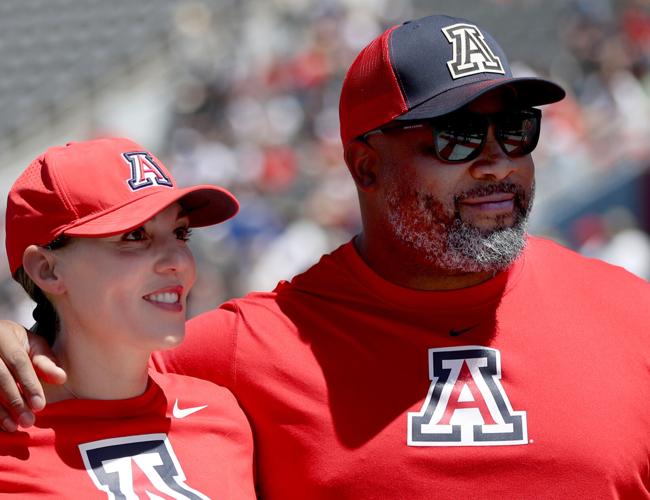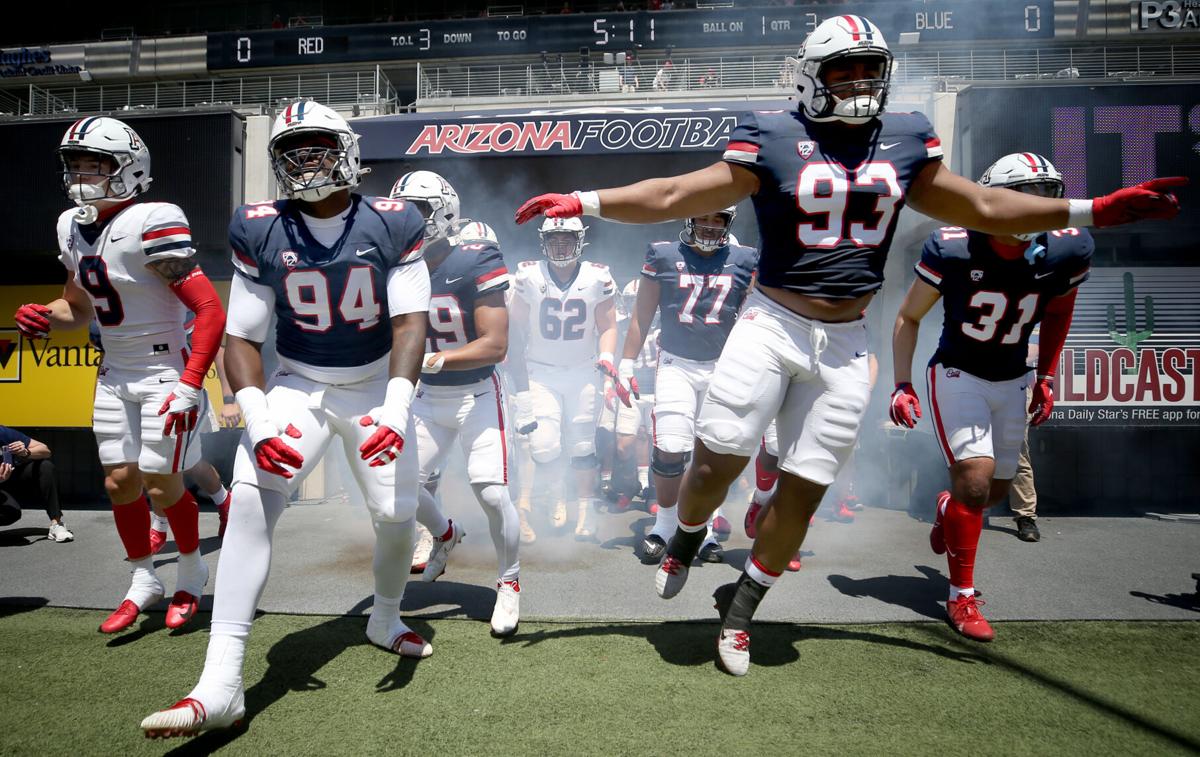If all goes according to Jedd Fisch’s boundless ambition, Arizona’s spring football game will someday draw 15,000 or 20,000 fans, he will no longer have to hire entertainment acts, supply thousands of free water guns to fans, or count on Tedy Bruschi and Adia Barnes to help create a buzz.
But for now, Arizona’s spring game is still a tough sell, and not all of it has to do with a team coming off a 1-11 season.
It was 91 degrees Saturday when Arizona kicked off its spring game, and that’s never going to work. The Pac-12 Networks schedules the league’s spring games, and all of them start between noon and 2 p.m., filling gaps in the network’s forever-challenged programming schedule.
It would’ve been interesting to see how many UA fans would’ve been at Arizona Stadium for, say, a 6:30 p.m., kickoff. Maybe 10,000. Maybe more. The wall-to-wall positivity emitted by Fisch’s football program — its bountiful recruiting harvest and continued commitment to elite-level coaching staff — has kick-started a lot of optimism.
But 91 degrees can be a rally-killer.
Fisch’s overhaul of Arizona’s wayward football operation isn’t really a rebuilding job as much as it’s a full transplant. Part I is working, which is restoring community relations and reconnecting with what had become a detached alumni base.
When I walked into Arizona Stadium just before noon Saturday, I saw familiar faces everywhere: Marc Lunsford, the Singleton twins, Jose Portillo, Willie Tuitama, Art Greathouse, Will Walker, Reggie McGill.
I had to pause to write down the names of ex-Wildcats important to the school’s football success of the last 50 years. On Friday, the school helped Hall of Fame coach Jim Young arrange a banquet with about 40 of his early 1970s players, a period during which the Wildcats went 26-7.
To his credit, Fisch has reached out to everyone, and it is working. He estimated that at least 250 former Wildcats returned to campus for the weekend. In a golf outing Friday at Forty Niner Country Club, two men who assisted greatly in breaking up ASU’s domination of the Territorial Cup — Chuck Cecil and Craig Vesling — shared a golf cart.
Talk about getting the gang back together. It was Vesling’s last-minute quarterback sack that clinched a 1984 comeback victory over the Sun Devils. Two years later, it was Cecil’s fourth-quarter interception return that sunk ASU on the same piece of turf.
The Veslings and the Singletons and the Greathouses had an up-close view of Saturday’s potential program-changing figures, especially young quarterbacks Jayden de Laura and Noah Fifita.

UA women’s basketball coach Adia Barnes and former UA and NFL standout Lance Briggs pose for a photo after Saturday’s coin toss.
Fifita and de Laura can play. It took about five snaps to see that Saturday. Fifita, a freshman, has arm strength, accuracy and command that go beyond his modest size (he is 5 feet 9 inches). De Laura can improvise as well as run Fisch’s NFL-style offense. When Fisch declined to name a No. 1 quarterback entering the offseason, de Laura shrugged. He knows he can successfully play in the Pac-12.
If you’ve got a Pac-12-caliber quarterback, you’re not going to go 1-11 any longer.
If you’ve got a Pac-12-caliber offensive line, you’re not going to go 1-11 any longer, either.
The UA’s reconfigured offensive line passes the eye test. Marana tackle Jordan Morgan is 6-5, 335. His partner on the other side of Arizona’s offensive line, Paiton Fears, is 6-5, 330. Guard Jonah Savaiinaea, a freshman, is 6-4, 335.
And they’re just not big. They look like linemen at USC and Oregon, which hasn’t been the case at Arizona in what seems like forever.
“I feel stronger, quicker, smarter,” Morgan said last week. “I got a little more weight, I feel healthier, I can move better, I’m stronger overall.”

Safety Isaiah Taylor, left, and linebacker Kolbe Cage put the squeeze on running back Stevie Rocker Jr., during Saturday’s spring game.
Morgan and Savaiinaea also have multiple years of eligibility remaining. It is one of the first tangible signs that Fisch’s rebuild/transplant is functioning on the player-development front. The depth chart, while young, is now populated with perhaps more Pac-12 level players than at any time since 2014 or thereabouts.
Yet Arizona’s 2022 schedule is so imposing that the immediate road ahead may be as difficult as it has ever been at Arizona.
As Arizona’s spring game began Saturday, it was 49 degrees in wintry Fargo, North Dakota, home of the defending and seven-time FCS national champion North Dakota State Bison. For its spring game, NDSU expects a sellout at the 18,000-seat Fargodome on April 26. The Bison will receive their national championship rings.
North Dakota State will play at Arizona Stadium on Sept. 17. At a media session prior to spring ball, NDSU coach Matt Entz said “we’re going to be a bigger, faster, stronger version of the Bison.”
Gulp. NDSU is the “softie” of Arizona’s non-conference schedule, one that includes a Sept. 10 home game against Mike Leach’s Mississippi State Bulldogs and a Sept. 3 opener at San Diego State, which is coming off its best-season ever, 12-2.
And did I mention the game will be played at brand new Snapdragon Stadium, about four miles from SDSU’s campus, with an inaugural game sellout of 35,000 expected for the Aztecs? The Aztecs have already sold 11,000 toward a season-ticket goal of 18,000.
No one said this was going to be easy.
Arizona has 41 new players on campus this spring and will add about 15 more over the summer. It is a work in progress that has already progressed from Stage I to Stage II.
Bring on the Bison, right?
Photos: 2022 University of Arizona football Spring Game
University of Arizona Spring Game
Updated
Safety Jaydin Young leaps in to intercept a pass intended for receiver Jacob Cowing off the head of Blue teammate DJ Warnell Jr. in the first quarter of the University of Arizona's Spring Game at Arizona Stadium, Tucson, Ariz., April 9, 2022.
University of Arizona Spring Game
Updated
Quarterback Jayden de Laura cuts back against linebacker Ammon Allen during the University of Arizona's spring game at Arizona Stadium on April 9, 2022.
University of Arizona Spring Game
Updated
The Wildcats pour out of the tunnel to take the field for the University of Arizona's Spring Game at Arizona Stadium, Tucson, Ariz., April 9, 2022.
University of Arizona Spring Game
Updated
Receiver Jamarye Joiner takes a quick break from filling water balloons to dance to the music on the sidelines at Arizona’s 2022 spring game at Arizona Stadium.
University of Arizona Spring Game
Updated
University of Arizona women's basketball player Sam Thomas spikes the ball after catching a pass counted as a touchdown from Jordan McCloud in the Spring Game at Arizona Stadium, Tucson, Ariz., April 9, 2022.
University of Arizona Spring Game
Updated
Defensive lineman Ugochukwu Nosike hoses down the fans during a hot afternoon for the University of Arizona's Spring Game at Arizona Stadium, Tucson, Ariz., April 9, 2022.
University of Arizona Spring Game
Updated
Acting coach Teddy Bruschi, left, and honorary captain, former Wildcat softball coach Mike Candrea head to midfield for the coin flip at the University of Arizona's Spring Game at Arizona Stadium, Tucson, Ariz., April 9, 2022.
University of Arizona Spring Game
Updated
Honorary captain head women's basketball coach Adia Barnes and acting coach Lance Briggs pose for a photo after the coin flip to start the University of Arizona's Spring Game at Arizona Stadium, Tucson, Ariz., April 9, 2022.
University of Arizona Spring Game
Updated
Safety Isaiah Taylor, left, and linebacker Kolbe Cage put the squeeze on running back Stevie Rocker Jr., during the University of Arizona's Spring Game at Arizona Stadium, Tucson, Ariz., April 9, 2022.
University of Arizona Spring Game
Updated
Running back Jalen John looks for pursuit on his way to the end zone after catching a pass during Arizona's spring game at Arizona Stadium on April 9, 2022.
University of Arizona Spring Game
Updated
Head coach Jedd Fisch watches his Wildcats line up for a play at the University of Arizona's Spring Game at Arizona Stadium, Tucson, Ariz., April 9, 2022.
University of Arizona Spring Game
Updated
Receiver Kevin Green Jr. tries to utilize a block from lineman Jordan Morgan to get past safety Jaxen Turner in the University of Arizona's Spring Game at Arizona Stadium, Tucson, Ariz., April 9, 2022.
University of Arizona Spring Game
Updated
Lineman Jason Harris holds on just enough to stop running back Jonah Coleman on a run in the University of Arizona's Spring Game at Arizona Stadium, Tucson, Ariz., April 9, 2022.
University of Arizona Spring Game
Updated
Quarterback Jayden de Laura steps up to avoid the pressure form lineman Paris Shand during the University of Arizona's Spring Game at Arizona Stadium, Tucson, Ariz., April 9, 2022.
University of Arizona Spring Game
Updated
Quarterback Noah Fifita gets the throw over an onrushing Kevon Garcia and Stevie Rocker Jr., at the University of Arizona's Spring Game at Arizona Stadium, Tucson, Ariz., April 9, 2022.
University of Arizona Spring Game
Updated
Running back Jonah Coleman, left, comes in to celebrate with receiver Tetairoa McMillan after he reeled in a touchdown catch in the final minutes of the University of Arizona's Spring Game at Arizona Stadium, Tucson, Ariz., April 9, 2022.







